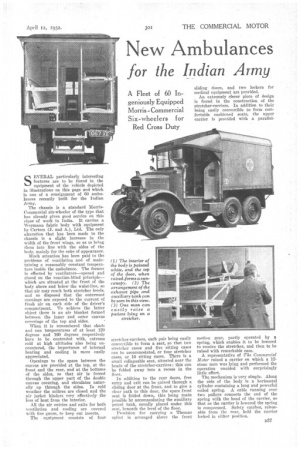New Ambulances
Page 55

If you've noticed an error in this article please click here to report it so we can fix it.
for the Indian Army
A Fleet of 60 Ingeniously Equipped Morris-Commercial Six-wheelers for Red Cross Duty
SEVERAL particularly interesting features are to be found in the equipment of the vehicle depicted in illustrations on this page and which is one of a consignment of 60 ambulances recently built for the Indian Army.
The chassis is a standard MorrisCommercial six-wheeler of the type that has already given good service on this class of work in India. It carries a Weymann fabric body with equipment by Carters (J. and A.), Ltd. The only alteration that has been made to the chassis is a slight increase in the width of the front wings so as to bring them into line with the sides of the body, mainly for the sake of appearance.
Much attention has been paid to the problems of ventilation and of maintaining a reasonably constant temperature inside the ambulance. The former is effected by ventilators—opened and closed on the venetian-blind principle— which are situated at the front of the body above and below the waist-line, so that air may reach both stretcher levels, and so disposed that the outermost openings are exposed to the current of fresh air on each side of the driver's compartment. To achieve the latter object there is an air blanket formed between the inner and outer canvas coverings of the top and sides.
When it is remembered that shade and sun temperatures of at least 120 degrees and 160 degrees respectively have to be contended with, extreme cold at high altitudes also being encountered, the importance of internal heating and cooling is more easily appreciated.
Openings to the space between the canvas are provided at the top, at the front and the rear, and at the bottoms of the sides, so that air is forced through the upper part of the double canvas covering, and circulates naturally up through the aides. In cold weather the orifices are closed and the air jacket hinders very effectively the loss of heat from the interior.
All the air entries and exits for both ventilation and cooling are covered with tine gauze, to keep out insects.
The equipment consists of four stretcher-carriers, each pair being easily convertible to form a seat, so that two stretcher cases and five sitting cases can be accommodated, or four stretcher cases, or 10 sitting cases. There is a small collapsable seat, situated near the heads of the stretcher-carriers; this can be folded away into a recess in the floor.
In addition to the rear doors, free entry and exit can be gained through a sliding door at the front, and to give a clear path to this door, the spare front seat is folded down. this being made possible by accommodating the auxiliary petrol tank, usually placed under this seat, beneath the level of the floor.
Provision for carrying a Thomas splint is arranged above the front motion gear, partly operated by a spring, which enables it to be lowered to receive the stretcher, and then to be raised with remarkable ease.
A representative of The Commercial Motor raised a carrier on which a 12stone man was lying and performed the operation unaided with surprisingly little effort.
The mechanism is very simple. Along the side of the body is a horizontal cylinder containing a long and powerful coiled spring. A cable running over two pulleys connects the end of the spring with the head of the carrier, so that as the carrier is lowered the spring is compressed. Safety catches, releasable from the rear, hold the carrier locked in either position.




































































































